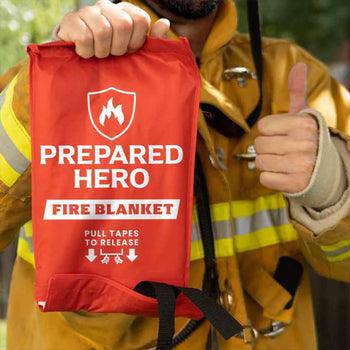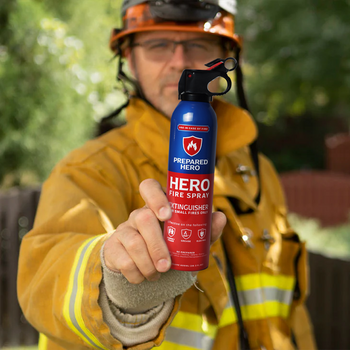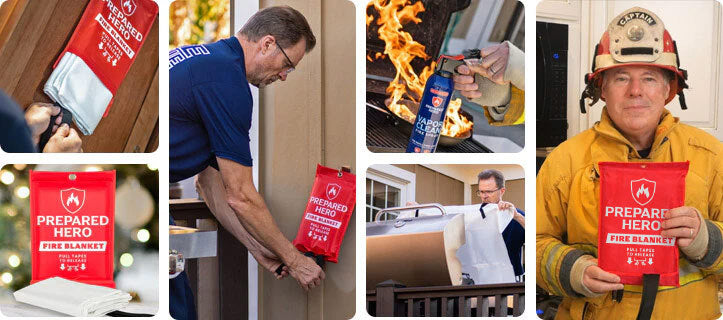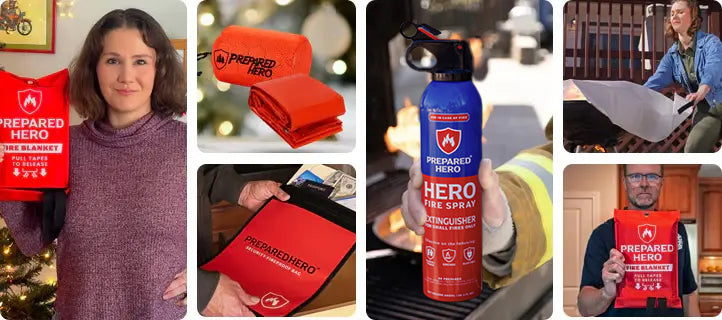Where you put your smoke detectors matters just as much as installing them. Proper placement makes sure they can detect...
Smoldering fires are the silent killer because they’re hard to notice. But how exactly do they work? How dangerous are they? How do you put them out? Find out below.
What Is Fire?

Fire is a chemical reaction that happens when heat, fuel, and oxygen come together. This combination is called the fire triangle. Without one of them, the fire can’t start or keep going. The reaction produces heat, flames, smoke, and sometimes dangerous gases, like carbon monoxide.
Here’s how it works: the fuel (like paper or wood) gets hot enough to reach its ignition point. Once it hits that temperature, it reacts with oxygen in the air and catches fire. As the fire burns, it creates more heat, which can make nearby materials catch fire too. That’s how fire spreads.
Fire isn't a gas, solid, or liquid. It’s a process. Some sources say it’s a form of plasma, but not the kind you see in a science lab. Either way, what we see as flames is just the visible part of the heat and light generated by the chemical reaction.
Depending on what’s burning and how hot it is, the color of the flames can change. Red is cooler, while white or blue flames are hotter. Fire can be helpful, but it can be deadly if it spreads fast or gets out of control.
How Hot Is Fire?
Fire is hot, but the exact temperature depends on what’s burning and how much oxygen is around. Wood fires usually reach about 1,027°C (1,880°F). Some fuels, like acetylene, can burn up to 3,100°C (5,612°F). Even a lit candle burns at around 1,100°C (2,012°F).
Color also tells you a lot. Red flames burn at about 525°C (977°F). As the flame gets hotter, it shifts to orange, yellow, then blue. Blue flames mean efficient burning and are usually seen in gas stoves. The hottest colors—white and purple— can weld and melt metal.
Fire also gets hotter as it spreads. Within a few minutes, a house fire can go from under 88°C (190°F) to 760°C (1,400°F). That’s enough to ignite everything in a room at once. Plus, fire can start with a bit of heat. But once it’s going, it releases way more. That’s why it’s important to act fast in a fire and have safety tools like a fire blanket and fire spray nearby.
What Is a Smoldering Fire?

A smoldering fire is a slow-burning fire that doesn’t have flames. It occurs when oxygen reacts with the surface of solid materials, such as wood, foam, tobacco, or peat. Instead of bursting into flames, these materials glow and burn slowly. Think of a lit cigarette or the hot embers in a fireplace.
What makes smoldering dangerous is that it can quietly start fires without anyone noticing. For example, a cigarette dropped on a couch can smolder for a while before turning into a full-blown fire. It also releases a lot of toxic gases.
Plus, smoldering is common in wildfires, especially in peat or coal deposits. These underground fires can burn for months or even years. One extreme example is Australia’s Burning Mountain, which has been smoldering for thousands of years.
In addition, smoldering fires are tricky because they’re hard to see and put out. They might look harmless at first, but they’re a major fire hazard and tough to control once they spread.
What Is a Flaming Fire?
A flaming fire is the kind you usually picture when you think of a fire—bright, hot, and fast. It burns in the gas phase, which means the fuel has to turn into vapor before it can catch fire. Whether liquid or solid, the fuel has to be heated enough to release flammable gases first.
Flaming fires burn hotter than smoldering ones and have visible flames. They spread quickly and can cause serious damage, especially indoors. Once a fire gets going, it can move fast, heat up the room, and set off a chain reaction. That’s why things can go from bad to worse if you don’t act fast.
Fast-flaming fires are known for huge flames and less smoke. They’re often caused by flammable liquids, wood, paper, or open flames burning nearby items. Flaming fires also have high heat, can lead to a flashover, and spread in seconds. Common examples include oven and grease fires.
Differences Between Smoldering and Flaming Fires

Knowing how smoldering and flaming fires behave can help you stay safe. Here’s a quick look at how they compare—speed, smoke, danger level, and more.
| Smoldering Fire | Flaming Fire | |
| Speed | Burns slower | Burns quicker |
| Flames | No visible flames | Visible, bright flames |
| Smoke | Thick, toxic smoke | Less smoke |
| Heat | Lower temperature | Higher temperature |
| Where It Burns | On the surface of solid fuels | In the vapor above the fuel |
| Examples | Cigarette and peat fires | Grease and paper fires |
| How It Starts | Weaker ignition sources | Stronger ignition sources |
| Danger Level | Sneaky and toxic | Fast-spreading and intense |
| Detection | Harder to notice right away | Easier to detect |
| Common Settings | Living rooms and forests | Kitchens and storage rooms |
What Causes Smoldering Fires?
Smoldering fires usually start when dry, porous materials like peat, duff, or decaying wood get just enough heat and oxygen to start burning, without bursting into flames. These fires burn slowly and at lower temperatures.
One big cause is the type of fuel. Materials with a lot of small air pockets, like peat or soft, spongy wood, hold heat well and let oxygen sneak in. However, moisture usually slows smoldering down. So, if those materials are dry, especially after a drought, they’re more likely to smolder.
Oxygen plays a role, too. Smoldering fires don’t need a lot of oxygen― just a steady trickle through cracks, gaps, or underground tunnels. That small but constant airflow helps the fire stick around.
A smoldering fire can be caused by a spark, a dropped cigarette, lightning, or even heat building up from within the material itself. Human activity, like slash-and-burn farming or land development, can make things worse by creating the perfect setup for smoldering to take hold.
Is a Smoldering Fire Dangerous?

Smoldering fires are dangerous. They might not look scary at first because they burn slowly and don’t always have visible flames. But that’s part of the problem: smoldering fires can go unnoticed for a long time while building up heat, smoke, and toxic gases.
One of the biggest risks is carbon monoxide. Smoldering fires produce a lot of it, and it’s deadly. In fact, most fire-related deaths are linked to smoke and toxic gas inhalation, not burns. And since smoldering fires often happen in hidden spots like inside walls, under floors, or in furniture, people might not realize there’s a fire until it’s too late.
Smoldering fires can also quickly switch to flaming fires. That means a slow burn can turn into a fast, out-of-control fire if airflow increases. They’re also hard to put out. Smoldering can keep going for days or even months, especially in places like peatlands or debris piles. On top of that, they can damage the environment, kill trees, and mess with the soil.
Is It Ok to Leave a Fire Smoldering?
No, it’s not okay to leave a fire smoldering. Even if it looks like it’s almost out, smoldering embers can stay hot for hours and reignite with just a bit of oxygen. That small glow can quickly turn into a full fire, especially if there are dry leaves, grass, or other flammable materials nearby.
Smoldering fires are sneaky. They burn low and slow, which makes them easy to ignore. But that’s exactly why they’re risky. They’ve started wildfires, house fires, and more just because someone thought they were mostly out.
On top of the safety risk, leaving a fire unattended is often against the law in many places. You could end up with a fine or worse. So, always make sure the fire is completely out before you walk away. Put out the fire, stir the ashes, and feel for heat. If it’s still warm, it’s not done.
How Long Can a Fire Smolder?

A fire can smolder for a few hours, weeks, or longer, depending on what’s burning and the environment. Embers can stay hot and smolder for days in common scenarios, like after a campfire or house fire. The smoldering can also last longer if there’s a lot of fuel or poor ventilation.
Plus, materials like wood or peat hold heat and burn slowly. Even after the flames are gone, they can keep glowing under the surface. In wildfires, ground fires can smolder in roots or soil for weeks or months. In addition, coal mines and peat bogs have been known to smolder underground for years.
Can a Smoldering Fire Reignite?
Yes, a smoldering fire can reignite. Just because the flames are gone doesn’t mean the danger is over. Leftover embers and coals can stay hot for a long time. If they get enough oxygen, they can flare back up into a full fire.
This can happen hours, days, or even weeks after you thought everything was out. That’s why firefighters check for hot spots even after a fire looks like it’s out. It’s also why it’s risky to walk away from a fire that’s still smoldering.
Some wildfires have been known to survive through winter, buried under snow and soil, and re-emerge in spring. Whether it’s in a fireplace, a wildfire, or leftover ashes in a fire pit, a smoldering fire has to be fully extinguished and cooled. Otherwise, they can easily reignite.
How Do You Put Out a Smoldering Fire?

Smoldering fires can hang around longer than you think. Just because there’s no flame doesn’t mean it’s safe. Here’s how to put out a smoldering fire:
1. Stop adding fuel.
Let the fire start dying on its own. Don’t add more wood, paper, diesel, or any fuel.
2. Spread out the embers.
Use a stick, shovel, or poker to spread the coals and ashes around. This helps them cool off faster.
3. Smother the fire.
Cover the embers with something that blocks oxygen. You can use a fire blanket or fire snuffer. Sand or dirt works just as well, but you must be more careful when using it.
4. Add water if it’s safe.
Slowly pour water over the embers if it’s safe. You should hear a hissing sound. Continue pouring and stirring until everything is thoroughly soaked.
5. Stir and check.
Mix the ashes and water. Then, look for glowing spots. Add more water or dirt if needed.
6. Feel for heat.
Use the back of your hand to check for leftover warmth without touching the embers. Continue cooling them down if they’re still warm.
7. Never walk away too soon.
Stick around a little longer to be sure it’s completely out.
Conclusion
Smoldering fires might not look scary, but they’re no joke. They burn slowly, hide well, and can reignite if you’re not careful. So, always fully put them out and never walk away early. Remember, spending more time making sure they’re out is better than spending thousands on fixing fire damage.
Do you want reliable, easy-to-use, and affordable tools to put out smoldering fires before they spread? Check out Prepared Hero’s fire prevention tools here, and get up to 51% off on certain items. Stay prepared, hero!


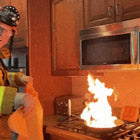 Fire
Fire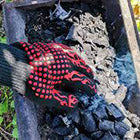 Safety
Safety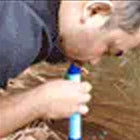 Survival
Survival Protection
Protection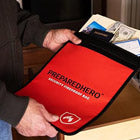 New
New
 Fire
Fire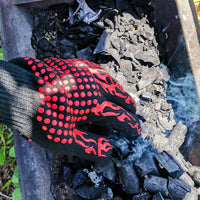 Safety
Safety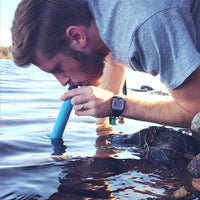 Survival
Survival Protection
Protection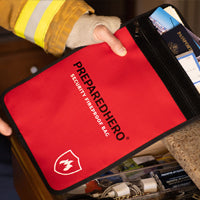 New
New
